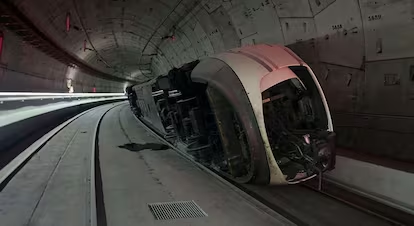
The Railway Accident Investigation Commission (CIAF) has made public a first and brief story about the derailment of a Renfe train last Saturday afternoon in the high speed tunnel that links the Madrid stations of Atocha and Chamartín. The event has been classified as “serious” and not extremely serious as there were no fatalities or serious injuries.
File 108/2024, which is the license plate that received the report opened that same Saturday, places the incident at 4:20 p.m. at kilometer point 6,900 of a 7,300-meter-long tunnel. At the moment, CIAF technicians only involve Renfe, as operator of the S114 series Avant train, and Adif as infrastructure manager. The commission has rushed to shed some light, in line with what was explained this week by Minister Óscar Puentebut warns that progress in the investigations may require some time. One of the first conclusions is that the departure of the track was favored, with a change of switches, to avoid greater evils.
“Train 97015 left La Sagra (Toledo) bound for the Fuencarral workshops (Madrid). It was made up of two units of the series 114 high-speed regional train: the first unit was towing the second, which was damaged,” begins the summary of a trip that would end up collapsing the high-speed corridors between Madrid and Levant due to the blockage of the tunnel with derailment. “The train crew was made up of a driver and two maintenance technicians,” corroborates the CIAF.
As is known, the Avant tugboat and the damaged one were traveling through the tunnel from Atocha to Chamartín, “but at the entrance to the Chamartín station the lead unit (tugboat) suffered a traction failure that prevented it from climbing the entrance ramp to the station (about 30 thousandths).” At this point, the investigators are already focusing on some type of breakdown in the machine of the first unit, which was the tugboat. In recent days there has been speculation about a failure in one of its engines, but the preliminary report does not shed any light on the matter.
“To overcome the ramp, the driver and the command post (Adif is involved) agreed that the train would go backwards to gain momentum from a flatter section. While this maneuver was being prepared, the damaged train unit (the towed one) broke free from its hitch and began to drift down the tunnel without brakes, without a battery and with the two technicians on board.” It is confirmed that the two workers, without mentioning that they were from Alstom, were traveling on the train that would drift “more than four kilometers through the tunnel, with slopes of between 12 and 30 thousandths.” There is also no explanation yet given as to the cause of the disengagement or the reason why any brake was activated. Until now there is unofficial talk of possible human error.
Regarding the outcome with the derailment at the Botanical Garden banalization station, the Avant without brakes “arrived at high speed” to the point “where it was changed from track number 1 to number 2.” At this moment in the uncontrolled and high-speed journey towards the south mouth of the tunnel, there came a curve, after changing tracks, in which “the unit derailed and went off on a tangent, crashing into the tunnel wall.” The first three cars overturned, while the fourth remained derailed, but upright. The train continued to crawl and “stopped at approximately kilometer point 7,000. “The two maintenance technicians who were on board the train were able to escape safely after it stopped.”
The CIAF reveals the existence of “serious damage, both to the injured unit and to the tunnel infrastructure” and anticipates that it has given the incident the aforementioned category of “serious accident” in accordance with the regulations governing accident investigation. railways. In this case, the amount of damage caused to the underpass is taken into account. open summer 2022 and its effect on security management. The in-depth investigation is opened ex officio.
Whether or not there was a possibility that this derailed train could collide with another stopped at the bottom of the tunnel and with passengers on board, the CIAF has avoided offering any details.
The investigation now enters a phase, as stated in article 15.2 of Royal Decree 623/2014 of July 18, in which access to information about the event is offered to the groups involved, including the railway operators or Adif itself. , “as long as it does not harm the objectives of the investigation and is compatible with it.”

